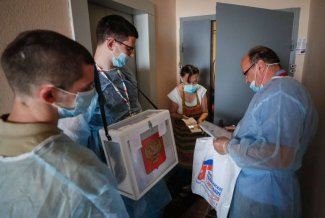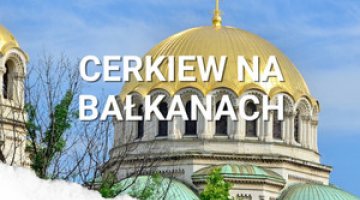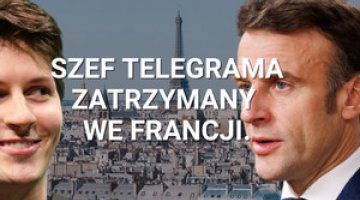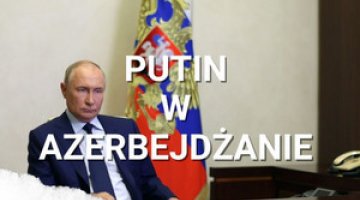A farce at the ballot box. The constitutional vote in Russia

A nationwide vote on constitutional amendments was held in Russia from 25 June to 1 July. The main objectives of the constitutional reform are to enable Vladimir Putin to potentially hold the office of president until 2036, and to consolidate the authoritarian regime and strengthen the head of state’s position in the political system. These goals were camouflaged by a package of amendments appealing to a sense of social justice (including constitutional guarantees that social benefits would be linked to inflation) together with ‘ideological’ amendments (including references to ‘traditional values’, the historical inheritance and legacy of the USSR).
In the conditions of the pandemic the vote, which was held in contravention of the current constitution’s provisions, turned into a farce. Under the pretext of ensuring public safety, the options for early voting (in total the voting process lasted a week), as well as voting online and outside polling stations, were greatly extended. The latter also included voting in private homes with virtually no restrictions. These are the least transparent options for voting possible; they lack any effective supervision by observers, and open up the broadest space for falsifying both the turnout and the results. Numerous cases have been reported of pressure from the administration and public sector employers to increase turnout. The state-controlled media and state institutions conducted an overt propaganda campaign in support of the amendments. Violations on a significant scale of the secret ballot, votes being cast by third parties and falsification of results have been noted. The work of independent observers was frequently blocked. The official result (almost 78% in favour of the amendments) does not reflect the actual will of the voters at all. The degree to which the authorities have falsified the voting results cannot be estimated exactly, but it was certainly significantly higher than usual.
The way the vote was organised demonstrates, on the one hand, the unprecedented determination of the authorities; and on the other, their growing arrogance and abandonment of any pretence of legality. We should expect such trends to continue in the coming years; this will further weaken the legitimacy of the regime in the eyes of society, and deepen the alienation of the public towards the state.
The crowning of an era
The Kremlin had planned to mark 2020 as a kind of coronation of Vladimir Putin’s twenty-year rule, based on the solemn commemoration of the 75th anniversary of the victory over Nazism and the reform of the Russian constitution, the latter having been prepared in a lightning-fast ‘special operation’. However, the COVID-19 pandemic not only forced changes to be made to the original timetable, but also weakened the intended propaganda tone of both events. While the commemoration was considered key to promoting Russia’s foreign policy goals and the regime’s domestic political legitimacy, the constitutional reform was, above all, of fundamental importance for its internal policy.
The essence of these important constitutional amendments boils down to two issues: first, the final formalisation and consolidation of the strongly presidential system (by expanding the power of the head of state at the expense of the government, parliament and judiciary); and second, opening up the possibility that Putin could potentially remain in the office until 2036 (according to the current constitution, he would not have been able to stand for election in 2024). The reform’s most important elements were encapsulated in a package of amendments guaranteeing the indexation of social benefits, the inviolability of Russia’s borders (thus making the annexation of Crimea irreversible), the ‘sovereignisation’ of Russia’s attitude towards the international law commitments it has undertaken (i.e. the superiority of the national legal order over international law), as well as references to traditional values, the heritage of the USSR, and the defence of ‘historical truth’.
This package of numerous and diverse amendments was put to the vote as a whole, although public support for the individual changes was extremely variable (according to surveys by independent sociologists, on average 80% of respondents supported the social and ‘identity-based’ amendments, while only 24% were in favour of the amendment allowing Putin to extend his rule after 2024).
Despite the seriousness of the epidemic within Russia, the vote was held because of the Kremlin’s fear that public sentiment would deteriorate further in the face of the predicted deep recession (the fall in GDP is estimated to amount to c. 6% in 2020, and the public finance deficit may even rise above 8%). Even today, according to independent polls, both the level of public trust in Putin and support for his policies as president are the lowest in 20 years (25% and 59% respectively). The mood of protest is also intensifying; and disappointment with the ossifying regime, which has proved unable to stimulate development, is deepening.
From the outset the vote, which had no legal basis in the Russian Federation’s current constitution, was planned as a plebiscite of support for Putin and a ‘new opening’ to legitimise his continued rule. The question remains open as to how much this plebiscite was a response to deteriorating public sentiment, and how much to the unfavourable mood against the president within the ruling elite. As Putin himself has said, the representatives of the establishment had to be discouraged from frantically looking around for a possible successor to him.
The main message accompanying the campaign for the amendments (which was referred to as ‘information’, while no campaigning against the amendments was permitted) was based on an appreciation of Putin’s stability and ‘sovereignty’ on the international stage. The propaganda setting was carefully thought out. Voting began the day after the postponed celebration of the victory over Nazism. In recent weeks Putin addressed the nation with unprecedented frequency – practically every few days – highlighting his government’s achievements in the fight against coronavirus, presenting further packages of social support during the crisis (the last of which was on 23 June) and calling for the citizens to participate in “shaping the future of the country” by taking part en masse in the plebiscite. On the main voting day (1 July), all Russian families received an allowance of 10,000 roubles (c. US$140) for every child they have.
How the vote took place
Due to domestic political priorities, it was of particular importance for the Kremlin to obtain a sufficient turnout and high support for the constitutional amendments. The voting was not legally regulated in the correct way; the rules and procedures which usually apply to traditional elections and referendums were absent, which led to legal chaos and the lack of formal guarantees of voters’ rights. Procedures were made more flexible by extending – on an unprecedented scale – the options for early voting, voting outside polling stations (including at home) and voting online (in Moscow and the Novgorod oblast). These mechanisms are the least transparent and the least subject to supervision. The Central Electoral Commission permitted early voting without an appropriate legal basis: thirty days should have elapsed between Putin’s decree of 1 June and the start of the vote. The main innovation of the constitutional vote, as compared with elections held in the past, was that it became virtually impossible to collect evidence of manipulation and forgery, due to the extension of the voting process in time and space, as well as the restrictions on election monitoring and the presence of media representatives on electoral committees. Only pro-Kremlin structures were entitled to nominate the observers, although the independent organisation Golos, which has been monitoring the elections in Russia for years, did manage to send its own observers to 42 regions around the country.
After the voting week, concerns about the falsification of the turnout and the results were confirmed. One common phenomenon was putting administrative pressure on citizens to take part in voting, including by registering online or voting at workplaces (which not only increased the turnout, but also facilitated voting by third parties). Employees were required to prove that they had taken part in the plebiscite. Other traditional methods of driving up turnout included organising attractive lotteries on voting day. Against the background of the authorities’ determination, the democratic opposition lacked a coherent strategy: some circles called for a boycott, while others urged voters to participate and vote against the changes. Shortly after the early voting phase began, independent media discovered a pattern of organised trafficking in the personal data of pensioners and unregistered SIM cards in Moscow to register and vote online, without the knowledge of the voters concerned. Up to 80% of voters participated in the early voting (including electronic voting), and the number of people registered as voting from home increased many times compared to elections in previous years. This can only partly be explained by the epidemic; maximising the actual or fictitious turnout in both these forms of voting makes it de facto easier to falsify the results. Voting took place outside polling stations, for example in parked cars, playgrounds, benches, shops or even staircases; naturally there were no surveillance cameras in these places, and often the principle of secrecy was not observed. There were quite a few cases when people arrived at polling stations only to learn that they had ‘already voted’; multiple voting also proved possible. In violation of the regulations, neutral observers and even ‘disloyal’ committee members were removed from monitoring the voting process, denied access to committee documents, and sometimes suffered physical assaults. Government officials have disavowed the numerous reports of violations, calling them fake news.
The official national turnout figure was 65%, but the figures varied considerably between the regions: from over 90% in Chechnya and Tuva (support there was 97-98%) to less than 42% in the Khabarovsk krai and Irkutsk oblast. ‘Turnout anomalies’ often occurred, when the turnout varied widely in comparable districts within one region. In one electoral committee in Ufa (Bashkortostan) where an observer was present, the official turnout was half the figure officially announced in almost thirty other districts.
According to official data (after 100% of the votes had been counted) 77.92% of participants voted in favour of the changes, and 21.27% against. These data are similar to the results of polls and exit polls published before and during the vote by state sociological centres, although they differ significantly from independent polls, in which the support varied around 50-55%, with a turnout of over 60%. The authorities were apparently seeking a result comparable to the support Putin obtained in the last presidential election in 2018 (almost 77%). Most often people voted against the amendments in the traditionally ‘opposition’ regions of Siberia and the Far East. The only region that rejected the amendments was the Nenets autonomous district (55.3% of votes against); this was most likely an expression of opposition from both the residents and the local elites to plans to unite the region with the Arkhangelsk region. It is impossible to assess the exact degree to which the authorities faked the voting results, but it was certainly significantly higher than usual in the parliamentary and presidential elections. A mere hint of the truth here may be the estimates made by the Russian physicist Sergei Shpilkin, who has been studying the results of voting in Russia for years. Based on a statistical analysis of the anomalies, he found 22.4 million of the votes to be suspicious, i.e. almost a third of the total votes officially cast (more than twice as many as in the presidential elections of March 2018).
Conclusions
The way the constitutional plebiscite was organised marked an open break with the Kremlin’s previous policy based on the attempts to maintain the appearance of legalism (even if the law in Russia has continuously been instrumentalised). Making the voting process into a carnival, which then turned into a farce, testifies on the one hand to the government’s determination to achieve the desired results at any cost; and on the other to its growing arrogance. The results do not in any way reflect the real mood of the citizens.
Against this background, the demands by the representatives of the Federation Council, the upper house of the Russian Parliament, regarding the use of ‘flexible’ voting mechanisms (early voting, online voting) during future elections, out of concern for the voters’ ‘convenience’, are alarming. If the proportion of the vote which is not subject to practically any form of supervision is maintained or expanded, especially during the parliamentary elections scheduled for 2021, the gradual re-Sovietisation of Russian politics will have been completed; the relationship between the voters’ preferences and the official results will finally have been broken. This will further erode the regime’s legitimacy in the eyes of the public, and deepen the citizens’ alienation towards the state and the law (30% of Russians already believe that the constitution does not play a significant role in the state, and the percentage of respondents who believe that it does defend their rights and freedoms has fallen to 27% in recent years). If the economic situation deteriorates significantly, this may greatly increase the active potential for protest, to which—in the absence of other effective instruments— the authorities will only be able to respond with intensified repression.




